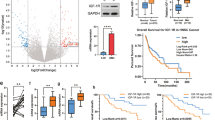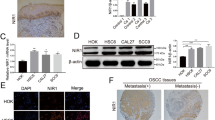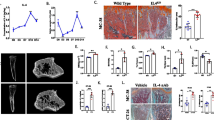Abstract
Nasopharyngeal carcinoma (NPC) is a common malignancy in southern China and Southeast Asia. NPC frequently metastasizes to the bone in advanced patients resulting in high mortality. The molecular mechanisms for NPC development and cancer-induced bone lesions are unclear. In this study, we firstly determined chemokine receptor CCR2 and CXCR6 expressions in clinical specimens and CNE2, SUNE1, CNE1, and HK1 cell lines. Then, we measured chemokine CCL2 and CXCL16 production in these NPC cell lines by ELISA. Expression levels of these chemokines and their receptors were observed to positively correlate with tumor aggressiveness. Furthermore, U0126 (MEK inhibitor) was used to treat these NPC cell lines. CCL2 and CXCL16 expression levels and cell proliferation were significantly inhibited by U0126 in a dose- and time-dependent manner. Finally, we collected conditioned medium (CM) from NPC cell cultures in the presence of U0126 treatment. When mouse bone marrow non-adherent cells were treated with the CM, the numbers of multinucleated osteoclast formation were dramatically diminished. These results indicate that MEK inhibitor diminishes NPC cell proliferation and NPC-induced osteoclastogenesis via modulating CCL2 and CXCL16 expressions. This study provides novel therapeutic targets such as CCL2/CCR2 and CXCL16/CXCR6 for advanced NPC patients.




Similar content being viewed by others
References
Adham M, Kurniawan AN, Muhtadi AI, et al. Nasopharyngeal carcinoma in Indonesia: epidemiology, incidence, signs, and symptoms at presentation. Chin J Cancer. 2012;31:185–96.
Wei KR, Zheng RS, Zhang SW, et al. Nasopharyngeal carcinoma incidence and mortality in China in 2010. Chin J Cancer. 2014;33:381–7.
Al-Sarraf M, LeBlanc M, Giri PG, et al. Chemoradiotherapy versus radiotherapy in patients with advanced nasopharyngeal cancer: phase III randomized Intergroup study 0099. J Clin Oncol. 1998;16:1310–7.
Yang TS, Ng KT, Wang HM, et al. Prognostic factors of locoregionally recurrent nasopharyngeal carcinoma—a retrospective review of 182 cases. Am J Clin Oncol. 1996;19:337–43.
Yeh SA, Tang Y, Lui CC, et al. Treatment outcomes of patients with AJCC stage IVC nasopharyngeal carcinoma: benefits of primary radiotherapy. Jpn J Clin Oncol. 2006;36:132–6.
Ma J, Mai HQ, Hong MH, et al. Is the 1997 AJCC staging system for nasopharyngeal carcinoma prognostically useful for Chinese patient populations? Int J Radiat Oncol Biol Phys. 2001;50:1181–9.
Coleman RE. Skeletal complications of malignancy. Cancer. 1997;80:1588–94.
Roodman GD. Mechanisms of bone metastasis. N Engl J Med. 2004;350:1655–64.
de Visser KE, Eichten A, Coussens LM. Paradoxical roles of the immune system during cancer development. Nat Rev Cancer. 2006;6:24–37.
Zou W. Immunosuppressive networks in the tumour environment and their therapeutic relevance. Nat Rev Cancer. 2005;5:263–74.
Balkwill F. Cancer and the chemokine network. Nat Rev Cancer. 2004;4:540–50.
Wang J, Lu Y, Koch AE, et al. CXCR6 induces prostate cancer progression by the AKT/mammalian target of rapamycin signaling pathway. Cancer Res. 2008;68:10367–76.
Ben-Baruch A. The multifaceted roles of chemokines in malignancy. Cancer Metastasis Rev. 2006;25:357–71.
Zlotnik A. Chemokines and cancer. Int J Cancer. 2006;119:2026–9.
Lu Y, Xiao G, Galson DL, et al. PTHrP-induced MCP-1 production by human bone marrow endothelial cells and osteoblasts promotes osteoclast differentiation and prostate cancer cell proliferation and invasion in vitro. Int J Cancer. 2007;121:724–33.
Zhang J, Lu Y, Pienta KJ. Multiple roles of chemokine (C-C motif) ligand 2 in promoting prostate cancer growth. J Natl Cancer Inst. 2010;102:522–8.
Lu Y, Cai Z, Galson DL, et al. Monocyte chemotactic protein-1 (MCP-1) acts as a paracrine and autocrine factor for prostate cancer growth and invasion. Prostate. 2006;66:1311–8.
Fang WB, Jokar I, Zou A, et al. CCL2/CCR2 chemokine signaling coordinates survival and motility of breast cancer cells through Smad3 protein- and p42/44 mitogen-activated protein kinase (MAPK)-dependent mechanisms. J Biol Chem. 2012;287:36593–608.
Lu Y, Cai Z, Xiao G, et al. Monocyte chemotactic protein-1 mediates prostate cancer-induced bone resorption. Cancer Res. 2007;67:3646–53.
Lu X, Qian CN, Mu YG, et al. Serum CCL2 and serum TNF-alpha–two new biomarkers predict bone invasion, post-treatment distant metastasis and poor overall survival in nasopharyngeal carcinoma. Eur J Cancer. 2011;47:339–46.
Matsumura S, Wang B, Kawashima N, et al. Radiation-induced CXCL16 release by breast cancer cells attracts effector T cells. J Immunol. 2008;181:3099–107.
Wente MN, Gaida MM, Mayer C, et al. Expression and potential function of the CXC chemokine CXCL16 in pancreatic ductal adenocarcinoma. Int J Oncol. 2008;33:297–308.
Seidl H, Richtig E, Tilz H, et al. Profiles of chemokine receptors in melanocytic lesions: de novo expression of CXCR6 in melanoma. Hum Pathol. 2007;38:768–80.
Taghizadeh R, Noh M, Huh YH, et al. CXCR6, a newly defined biomarker of tissue-specific stem cell asymmetric self-renewal, identifies more aggressive human melanoma cancer stem cells. PLoS One. 2010;5:e15183.
Hu W, Zhen X, Xiong B, et al. CXCR6 is expressed in human prostate cancer in vivo and is involved in the in vitro invasion of PC3 and LNCap cells. Cancer Sci. 2008;99:1362–9.
Lu Y, Wang J, Xu Y, et al. CXCL16 functions as a novel chemotactic factor for prostate cancer cells in vitro. Mol Cancer Res. 2008;6:546–54.
Parsonage G, Machado LR, Hui JW, et al. CXCR6 and CCR5 localize T lymphocyte subsets in nasopharyngeal carcinoma. Am J Pathol. 2012;180:1215–22.
Lu Y, Cai Z, Xiao G, et al. CCR2 expression correlates with prostate cancer progression. J Cell Biochem. 2007;101:676–85.
Hoffmann TK, Trellakis S, Okulicz K, et al. Cyclin B1 expression and p53 status in squamous cell carcinomas of the head and neck. Anticancer Res. 2011;31:3151–7.
Nigg EA. Mitotic kinases as regulators of cell division and its checkpoints. Nat Rev Mol Cell Biol. 2001;2:21–32.
Hu W, Ding W, Yang H, et al. Weekly paclitaxel with concurrent radiotherapy followed by adjuvant chemotherapy in locally advanced nasopharyngeal carcinoma. Radiother Oncol. 2009;93:488–91.
Jung Y, Kim JK, Shiozawa Y, et al. Recruitment of mesenchymal stem cells into prostate tumours promotes metastasis. Nat Commun. 2013;4:1795.
Cook LM, Shay G, Aruajo A, et al. Integrating new discoveries into the “vicious cycle” paradigm of prostate to bone metastases. Cancer Metastasis Rev 2014.
Mundy GR. Metastasis to bone: causes, consequences and therapeutic opportunities. Nat Rev Cancer. 2002;2:584–93.
Loberg RD, Ying C, Craig M, et al. CCL2 as an important mediator of prostate cancer growth in vivo through the regulation of macrophage infiltration. Neoplasia. 2007;9:556–62.
Acknowledgments
This work was supported by grants from the National Natural Science Foundation of China (Nos. 81171993, 81272415, 81130046, 81272340, and 81030043), Guangxi Key Projects (No. 2013GXNSFEA053004), Guangxi Projects (No. 2012GXNSFCB053004), and Guangxi Ministry of Education (Nos. 201202ZD022 and 201201ZD004). The authors thank Dr.. Jiejun Fu for helpful discussions and Ms. Xiaolin Zhou and Ms. Xin Huang for the English editing.
Conflict of interest
None
Author information
Authors and Affiliations
Corresponding authors
Rights and permissions
About this article
Cite this article
Zhu, Y., Zou, C., Zhang, Z. et al. MEK inhibitor diminishes nasopharyngeal carcinoma (NPC) cell growth and NPC-induced osteoclastogenesis via modulating CCL2 and CXCL16 expressions. Tumor Biol. 36, 8811–8818 (2015). https://doi.org/10.1007/s13277-015-3595-8
Received:
Accepted:
Published:
Issue Date:
DOI: https://doi.org/10.1007/s13277-015-3595-8




